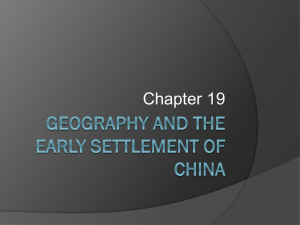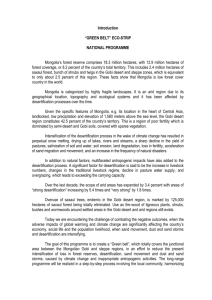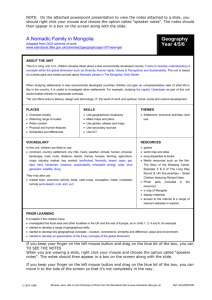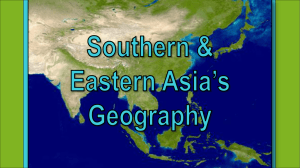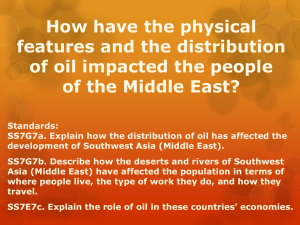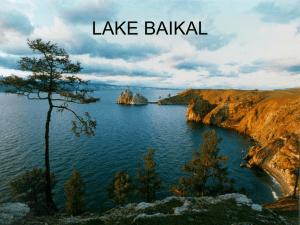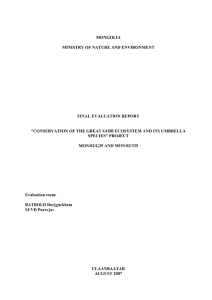PowerPoint presentation
advertisement
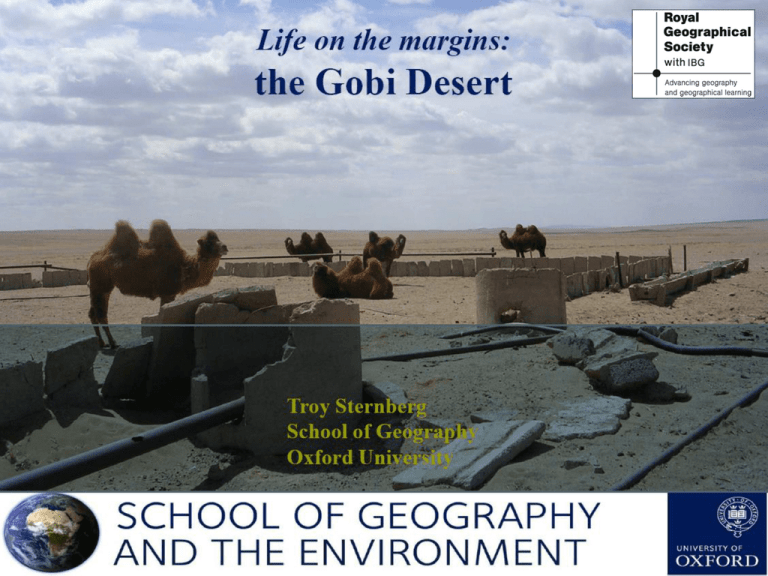
Starter: Background of the Gobi Desert – A land of extremes The Gobi is a cold desert that can reach -40 degree centigrade in the winter, however can be over 40 degree centigrade in the summer. It has a range of different landscapes, including white sand dunes, green pastures for herding and red sandstone formations. It is located on a plateau roughly 910– 1,520 meters above sea level. An average of approximately 194 millimetres of rain falls per year in the Gobi. Although a desert, there are some surface and underground rivers. Winter & summer conditions in the Gobi Desert: Location of the Gobi Desert: Mongolia is a country north of China. It has a rapidly changing economy. The ‘gold’ from the London 2012 Olympic medals was mined in Mongolia – which reflects its rapidly changing economy from predominately traditional nomadic herding to mining for export. The Gobi Desert cuts across both Mongolia and northern China. An area of China is called Inner Mongolia and it has been an ‘Autonomous Region’ of China since 1947, which means it has some from the Chinese government in terms of decisions about its economic future. However politics wise, Inner Mongolia is very similar to other Chinese states. Many people who live here are ‘Mongolian’ herders. Physical causes of the dry land Gobi Desert environment: The first step to understand is the Gobi desert’s location within the very large continent of Asia and is location a long way from the coastline. Most water in the atmosphere that causes rain is from evaporation from the seas – so the land closer to the sea receives more rain. Therefore a region such as the Gobi situated deep within a continent may become a desert as atmospheric currents carrying moisture from the sea has already travelled across land and rained, losing its moisture. In addition, the Gobi is located north of the large Himalaya mountain range – so any air currents flowing from India will have definitely been forced upwards and therefore to condense and rain through relief rainfall. However, some moisture reaches parts of the Gobi in winter as snow is blown by the wind from the Siberian Steppes. So, in summary, continentality has created a large desert with extremes in temperate and predominantly low rainfall. A land of extremes – winter & summer conditions in the Gobi Desert: ANSWERS: Physical causes of the dry land Gobi Desert environment: The first step to understand is the Gobi desert’s location within the very large continent of Asia and is location a long way from the coastline. Most water in the atmosphere that causes rain is from evaporation from the seas – so the land closer to the sea receives more rain. Therefore a region such as the Gobi situated deep within a continent may become a desert as atmospheric currents carrying moisture from the sea has already travelled across land and rained, losing its moisture. In addition, the Gobi is located north of the large Himalaya mountain range – so any air currents flowing from India will have definitely been forced upwards and therefore to condense and rain through relief rainfall. However, some moisture reaches parts of the Gobi in winter as snow is blown by the wind from the Siberian Steppes. So, in summary, continentality has created a large desert with extremes in temperate and predominantly low rainfall. A land of extremes – winter & summer conditions in the Gobi Desert: Location of the 3 field work sites, all in the Gobi Desert: 1) Minquin County in China. 2) Xilingol County in Inner Mongolia, China. 3) Omnogov & Dundgov provinces in Mongolia. Plastic to protect the crops from wind Irrigation channels (looking dry) Netting to reduce wind erosion and Dr. Troy Sternberg Minquin cont... Green houses built to protect crops from winter colds and winds Traditional tents: Some Mongolian customs remain A settled village – a change from Mongolian way of life Coal mines in the background; an expanding part of Xilingol’s economy. Herding cattle & goats is still the main farming method Plenary: Summarising the Hazards and Challenges in the 3 different field work locations Field work location 1 – Minquin, China If more rural workers move away from the Gobi, the area will be an ageing population – farming productively will become a challenge. The population will become dependent of food hand outs. Food secure Food insecure Water engineering paid for by government – farmers are more likely have enough due to fair quota system. Even if crops fail and farmers are unprofitable – the strength of the Chinese economy means they can buy wheat etc. on the international market to feed to their population. They will maybe sell this to rural populations in the Gobi subsidised (?). For now, China will always be food secure, in comparison to other dryland areas such as the Sahel. HAZARDS: Winter wind storms can damage expensive greenhouses – some farmers have taken out loans to buy this. They become indebted to the government. The farmers, dependent on high tech solutions have become less resilient. They may not be able to continue farming so have to move to eastern urban areas.


